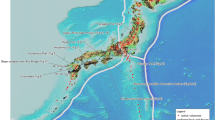Summary
Japan is an island lying off the east border of the Asian Continent. Its total area is about 370,000 km2 75% of the whole land area of Japan is mountainous. The lowlands, chiefly plains and alluvial fans, that constitute the remaining 25% are formed from sediments which have flowed there from the mountains in the past. In these lowlands live 85% of our population of 110 million people. Geologically, japan is extremely fragile and her topography is very steep. Under these conditions, sediment disasters caused by debris flow have occurred by torrential downpours, typhoons or the seasonal rain front in every year somewhere in Japan. These sediment disasters are the most harmful natural disaster to human life and property in Japan. For this reason the Sabo Law (Erosion Control Law) was enacted in 1897, and the government has exerted every effort to prevent such disasters. Thus Japan is one of the most advanced countries with regard to the study and research of sediment disasters and to the development of countermeasures.
Résumé
Soixante quinze pour cent des 370 000 km2 du Japon sont des régions montagneuses. Les basses terres, essentiellement des plaines et des dépôts de piedmont, qui représentent les 25% restants, sont formés de sédiments qui se sont répandus dans le passé depuis les zones montagneuses, 85% des 110 millions d'habitants vivent dans ces régions. Le Japon est très fragile et sa topographie est très accentuée. Dans ces conditions des désastres dus aux laves torrentielles provoquées par des orages violents, des typhons ou des pluies saisonnières abondantes se produisent tous les ans quelque part dans le pays. Ce sont les catastrophes naturelles qui provoquent le plus grand nombre de pertes en vies humaines et en biens matériels dans le pays. Pour cette raison, une loi sur le Contrôle de l'Erosion a été adoptée en 1897 (Loi Sabo) et le gouvernement déploie de grands efforts pour éviter de telles catastrophes. Le Japon est ainsi devenu un des pays où l'étude de ces phénomènes, ainsi que la mise au point de mesures préventives a été la plus poussée.
Similar content being viewed by others
References
IKEYA Hiroshi, (1973): Survey Results of Sediment Disasters in Japan, Doboku-Seko (Journal of Civil Eng. Execution), Vol. 14, No. 11, Sankai-do, appendix pp. 1–19.
IKEYA Hiroshi, (1974): A Study on the Standard Rainfall for Evacuation from Debris flow Disaster used by Ratio of Rainfall Intensity, Shin-Sabo, The Erosion-Control Engineering Society Japan, No. 94, pp. 7–11.
IKEYA Hiroshi, (1978): Classification of Debris flows, Civil Engineering Journal, Vol. 20, No. 3, pp. 44–49.
IKEYA Hiroshi and UEHARA Shinji, (1979): Experimental Study on Mudflow Countermeasures in Nojiri River, Sakurajima, Civil Engineering Journal. Vol. 21, No. 4, pp. 24–29.
IKEYA Hiroshi and YONEZAWAYA Seietsu, (1979): Study on the Setting of Debris flow Hazard Area (Second Report), Civil Engineering Journal, Vol. 21, No. 9, pp. 46–50.
IKEYA Hiroshi and ABE Souhei, (1980): A Study for the Debris flow Disaster at Horadani, Civil Engineering Journal, Vol. 22, No. 6, pp. 15–20.
IKEYA Hiroshi and UEHARA Shinji, (1980): Study on the Sediment Control of Slit Sabo Dam, Civil Engineering Journal, Vol. 22, No. 7, pp. 33–38.
IKEYA Hiroshi, (1981): Debris flow (II), Civil Engineering Journal. Vol. 23, No. 7, pp. 46–51.
IKEYA Hiroshi, (1981): Debris flow (VI), Civil Engineering Journal, Vol. 23, No. 11, pp. 47–52.
IKEYA Hiroshi and MIZUYAMA Takahisa, (1982): Flow and Deposit Properties of Debris flow, Report of The Public Works Research Institute, Ministry of Construction, Vol. 157, pp. 88–153.
IKEYA Hiroshi, (1987): Actual Example of Warning and Evacuating System in Nakatsugawa-City, Proc. of The Erosion-Control Eng. Society Symp., No. 19, pp. 8–18.
IMAMURA Ryohei and SUGITA Masami, (1980): Study on The Simulation of Debris Depositing Based on a Random Walk Model, Shin-Sabo, The Erosion-Control Eng. Society Japan, No. 114, pp. 17–26.
SUZUKI Masakazu, FUKUSHIMA Y., TAKEI A. and KOBASHI S., (1979). The Critical Rainfall for the Disasters Caused by Debris Movement, Shin-Sabo, The Erosion-Control Eng. Society Japan, No. 110, pp. 1–7.
TAKAHASHI Tamotsu, (1977): A Mechanism of Occurrence of Mud-Debris flows and Their Characteristics in Motion, Ann. Disaster Prevention Res. Inst., Kyoto Univ., No. 20B-2, pp. 405–435.
YAMAOKA Isao, (1981): Recent Study on Debris flows in River Channel, Hydraulic Committee of J.S.C.E., A-3.1-3.20.
Author information
Authors and Affiliations
Rights and permissions
About this article
Cite this article
Ikeya, H. Debris flow and its countermeasures in Japan. Bulletin of the International Association of Engineering Geology 40, 15–33 (1989). https://doi.org/10.1007/BF02590339
Published:
Issue Date:
DOI: https://doi.org/10.1007/BF02590339




